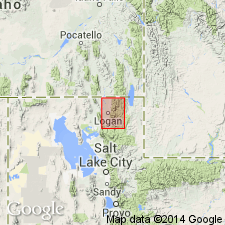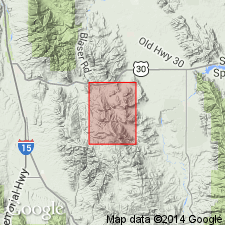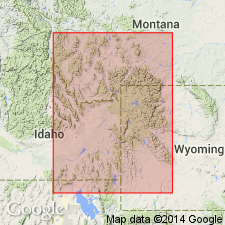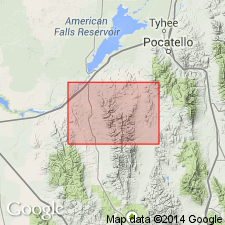
- Usage in publication:
-
- Beirdneau sandstone member
- Modifications:
-
- Original reference
- Dominant lithology:
-
- Sandstone
- AAPG geologic province:
-
- Wasatch uplift
Summary:
Pg. 1139, 1140. Beirdneau sandstone member of Jefferson formation. Composed wholly of buff-weathering sandstones. Thickness 820 to 920 feet. Overlies Hyrum dolomite member (new); gradational contact. Unconformably underlies Madison formation. Age is Late Devonian.
Named from continuous exposure about base of Beirdneau Peak, Logan quadrangle, [Cache Co.], northern UT.
Source: US geologic names lexicon (USGS Bull. 1200, p. 279).

- Usage in publication:
-
- Beirdneau Member*
- Modifications:
-
- Areal extent
- AAPG geologic province:
-
- Wasatch uplift
Summary:
Extended geographically into southeast ID. Mapped as upper member of Jefferson Dolomite in the northeastern part of the quad in Ts9 and 10S, R39E, Caribou Co, ID on the Wasatch uplift. Is 850 ft thick. Overlies Hyrum Member (rank raised) of Jefferson. Underlies Lodgepole Limestone. Of Late Devonian age.
Source: GNU records (USGS DDS-6; Denver GNULEX).

- Usage in publication:
-
- Beirdneau Formation
- Modifications:
-
- Revised
- AAPG geologic province:
-
- Wasatch uplift
Summary:
Pg. 2568 (fig. 1), 2570 (fig. 2), 2584-2585 (fig. 10), 2592-2593 (fig. 12), 2596-2599. Beirdneau Formation [previously Beirdneau Sandstone Member of Jefferson Formation]. In miogeosyncline of northeastern Utah and southeastern Idaho (Bear River and Wasatch Ranges), term Beirdneau Formation is applied to the light-colored sandy Devonian carbonates above the dark saccharoidal fetid dolomite of the Jefferson. Equivalent of the Logan Gulch and Trident Members of Three Forks Formation. Unconformably underlies Upper Devonian-Lower Mississippian Leatham Formation (which is considered equivalent of uppermost member of Three Forks, the Sappington). Age is Late Devonian.
Source: Publication.

- Usage in publication:
-
- Beirdneau Formation
- Modifications:
-
- Revised
- Areal extent
- AAPG geologic province:
-
- Snake River basin
Summary:
Geographically extended to the Snake River basin where it is raised to formation rank in Power Co, ID. Is 360 ft thick. Overlies Hyrum Dolomite (rank raised). Underlies Lodgepole Limestone. Lower contact placed at base of lowest sandstone or quartzite bed above the dark dolomite of the Hyrum. Of Late Devonian age. Geologic map. Measured sections.
Source: GNU records (USGS DDS-6; Denver GNULEX).
For more information, please contact Nancy Stamm, Geologic Names Committee Secretary.
Asterisk (*) indicates published by U.S. Geological Survey authors.
"No current usage" (†) implies that a name has been abandoned or has fallen into disuse. Former usage and, if known, replacement name given in parentheses ( ).
Slash (/) indicates name conflicts with nomenclatural guidelines (CSN, 1933; ACSN, 1961, 1970; NACSN, 1983, 2005, 2021). May be explained within brackets ([ ]).

